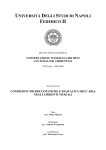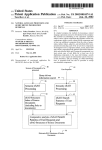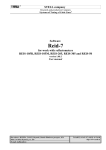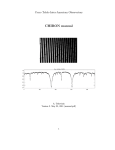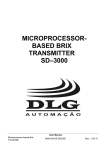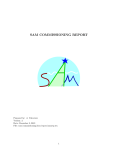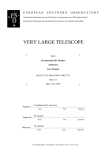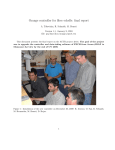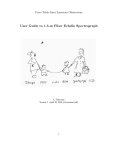Download Combined MASS-DIMM Instrument for measuring the
Transcript
Combined MASS/DIMM instrument for measurements of the atmospheric optical turbulence A Proposal to: European Southern Observatory (ESO) by Victor G. Kornilov, Sternberg Astronomical Institute, Moscow University September 21, 2005 1 1 Project goals The first Multi-Aperture Scintillation Sensor (MASS) was developed in a collaboration of Sternberg Institute (Moscow University) with Cerro-Tololo Inter-American Observatory and European Southern Observatory in 2001 – 2002 [1, 2] . The commissioning, test measurements and multiple crosscomparisons with different methods of the atmospheric turbulence sensing were conducted in 2002 – 2003. They revealed the reliability of the output data (turbulence profiles, integral quantities etc) and the capacity of this method to restore low-resolution turbulence profiles. In general, the results obtained on seeing from two instruments, MASS and DIMM, mimic each other [2]. Meanwhile, they start differing when the ground-layer turbulence becomes significant. Compared to DIMM, MASS provides a wider scope of information on turbulence, but is blind to altitudes below 0.5 km. Hence, DIMM results are complementary to MASS and allow thus to restore the full picture of the state of atmosphere for a given moment. The good idea was to combine both instruments as one MASS/DIMM instrument. Such device was developed and built for CTIO and TMT site testing programs in 2004. The numerous comparisons with other methods and between different copies show that this instrument provides and correct data on optical turbulence in the whole altitude range. We propose now to modify and implement new version of the turbulence profiler and seeing monitor MASS/DIMM, optimized for ESO demands. The instrument optics will be adopted for use with standard amateur telescopes Celestron 11. Whenever a computerized mount is available, the instrument will work unassisted. These MASS/DIMMs will be used in the following way: • Provide identical instrumentation for the site testing program directed to establishing of an optimal site for future ELT project. As the two year experience shows – the MASS/DIMM copies produce the well coincided results. • Participation in other site-testing activities and acquisition of data that are needed for calibration of hydrodynamic turbulence modeling, with a goal of understanding mechanisms of astronomical seeing. 2 Instrument overview The whole MASS/DIMM instrument includes: • Feeding Cassegrain type telescope with computerized mount. • The MASS/DIMM device itself with MASS electronics and mechanical interface for DIMM CCD camera. • DIMM CCD camera with its own interface to PC computer and its own software. • PC computer with a software for system control, data acquisition and processing. The system components work under the computer control and can make measurements in automatic mode without human intervention. So as the DIMM detector will be provided by another developer we do not discuss it in details. 2 2.1 MASS/DIMM device box The MASS/DIMM device includes following principal parts: • • • • • Common optics providing a light separation between MASS and DIMM channels. MASS channel optics providing further light segmentation in to A, B, C and D sub-channels. DIMM optical channel providing an double image on DIMM detector. Appropriate interface for adopted DIMM CCD camera. MASS electronics and its interface for connection to PC computer. The MASS/DIMM device is attached to the Celestron 11 or other Cassegrain-type telescope with similar parameters which collects the light of a single bright star to three clear sub-apertures of the diameter about 80 – 90 mm. The view of the device is presented in Fig. 1. Light from a telescope passes through the Fabry lens 1 which images the telescope entrance pupil in the exit pupil plane. A special segmentator 2 is placed there. The view of the exit pupil plane is presented in Fig. 2. The segmentator unit is more complex than the MASS PSU. It contains three parts (Fig. 2). Two equal concave mirrors with the diameter 10 mm and curvature radius about 90 mm, covered by mask with holes about 5.5 mm, provide two DIMM sub-apertures with the equivalent diameter 90 mm and separation 180 mm. Light in the DIMM channel is refocused on the CCD detector 3 (of ST2000X type, pixel size 7.4 micron) with the plate scale about 100”/mm. They form two star images, the separation between them is a few tens arc seconds and is adjustable by sub-aperture mirrors. The third part is similar to the MASS PSU [4], but is additionally inclined to provide the needed (non-symmetrical) light beams direction. The outer segment diameter is 5.50 mm. The concentric segments of the MASS segmentator have a certain curvature to provide non-divergent beams. We plan to use plastic MASS segmentator replices for us by A.Tokovinin from original metallic PSU. The light in the MASS channel is directed to the 4 PMTs 5 with help of four re-imaging mirrors. These mirrors 4 form the images of the corresponding concentric pupil segments on the photo-cathodes of the PMTs. Both MASS detectors and DIMM CCD detector work in unfiltered (white) light. Access to the PSU is provided from the bottom side of the instrument box via a special removable cover. The field of view of the instrument is limited by the field aperture 6 placed in the focal plane. The aperture has a diameter about 2 mm (2.5 arc minutes) and is needed to limit the sky background light. Before the field aperture a removable mirror 7 is placed. This mirror is inserted into the beam and reflects the light into viewer 8 for the star initial pointing. The field of view of the viewer is as wide as 10 arc minutes. 2.2 Electronics Instrument electronics is similar to the MASS electronics in its principles (See [4, 8]). But all logical modules will be physically located only on two printed circuit boards 9 to minimize connector problems. All four PMTs and appropriate amplifier-counter modules are assembled in a single detector module 11 on a single PCB. A protective shutter is provided for this module. The rest of electronics — the power DC/DC converter +12/+5 V, the high voltage converter and so on, which dissipate some heat, — is located on the second PCB mounted in the electronic box 12. These two boards are connected by special connectors. 3 1 7 4 8 6 3 4 9 5 8 2 Figure 1: Draft view of the instrument box (see text) Figure 2: Light separation between MASS and DIMM channel into exit pupil plane. Exit pupil is shown by blue. Yellow — MASS segmentator unit (PSU). DIMM masks are shown by cyan. Black — the placement of DIMM re-imaging mirrors DM1 and DM2 External connections for instrumental box are +12 V DC power supply and RS485 line to a standard PC computer. The line connects to the LPT port on PC via a custom-made RS485/LPT data converter. We plan to increase twice the transmission rate to provide sorter microexposure (0.5 ms). Working temperature range of all electronics is -10..+50 C. Heat dissipation is about 4 W. 3 Software So as a DIMM control software and telescope software remain out of the scope of this work, we can not propose the optimal solution of the separate program interactions. But the method which was used in matching of the MASS-LITE and ASM at Paranale, can be used for this project too. In this scheme, additional program (supervisor) controls the MASS observational process by sending messages (commands) to the MASS control program Turbina, checking before the status of the DIMM/ telescope program. All the programs share the single star list and some other service data needed for their work. For the synchronous DIMM and MASS work, the observation manager role is retained for DIMM which will decide on selection of the next star, shutting down and so on. 3.1 RS485 line driver: porting to Linux kernel 2.6 The data exchange between the host computer and the device is maintained via the half-duplex interface line based on a physical standard RS-485. The adaption of the line to the computer is made using the special converter RS485/LPT. The driver which serves this converter is developed for the Linux kernel versions 2.4. 5 The new Linux distributions are supplied with a kernel of a new version 2.6. Even if users of MASS/DIMM devices would like to change the Linux version to a newer one, the use of the current RS485 driver under the new kernel is not possible. These limitations on a use of existing driver complicate software installation and maintenance. We propose, as an outcome of the previous discussion, to start the MASS software upgrade with an RS485 driver modification making it compatible with new Linux kernel 2.6. 3.2 The development of the new generation of the MASS software The current version of Turbina program was developed primarily oriented to provide a convenient graphic user interface (GUI). This resulted in a close inter-relation of the flux measuring and device manipulation modules with the GUI. When the question on an automatic mode arose, some additional capabilities for the Turbina exchange with other components of the complex programs system were simply added with no serious reconsideration of Turbina basics. These later inserts have caused a considerable interference with the general concept of Turbina and, although most of these consequences were localized and corrected in 2003–2004, the full confidence in reliability and adequate view of the existing software are still absent. Multiple discussions of this problem with our colleagues which are interested in the MASS usage appeared also quite helpful and eventually lead to a principally different concept of the Turbina general structure. The new concept is based on a clear division of functionality and resources between different Turbina modules and the detailed development of the interface and protocols of their exchange. The main idea of this concept is to provide the most reliable performance of the measurement core, which consumes the minimal resources and makes only the limited amount of job. All remaining work (data processing, user interfaces etc) will be separated in other programs detached from the Turbina core. Up to now, we plan to divide the Turbina program into three independent program modules (see Figure). The first one works with the device and makes the statistical treatment of the PMT fluxes providing the raw measurements results. This is a core and it is organized like a server which may be accessed by other modules via sockets to manage the measurements. The sole output of the core will be the file with the statistical moments of fluxes and the device parameters. This will be the only module which is mandatory to observe with MASS and which must be run on the device host machine. The second module is the data interpreter. It consumes the core output, computes the scintillation indices, turbulence characteristics, etc., and stores the results in the output mass-file. It may be started at any moment on any machine and thus may do the on-line or stand-alone data processing. All the information which is needed for its work is obtained from the statistics and parameters read from the input file. In case of on-line processing, the data interpretation occurs immediately after the new information is found in the input. Finally, the graphic user interface will be provided which in some respect resembles the current Turbuna windows. It will help to make the core management simple and vivid, as in the current version. Most often this is needed while making the test measurements or determining the device parameters. Another function of the GUI is the on-line visualization of the measurement results which are currently under way at a given site. In case of robotic site testing, the GUI will be mostly in use via remote connection for data inspection (observations management is normally done by a local automatic supervisor, via the same socket connection). 6 MASS device RS485 Turbina core socket: commands stm + params file *.stm Data interpreter output data file *.mass Graphical interface socket: data samples Figure 3: Proposed re-structurization of the Turbina program in several program modules. Dotted line denotes the possible location of modules on different machines. 3.3 The support and maintenance of the software during campaigns As before, we are going to continue the checks of the performance of the software while the MASS measurements are under way at several sites. This includes bug fixing in Turbina modules, testing of the new software components in real observation conditions, support of organization of inter-program communication for management of robotic observations, support for migration from Linux kernel 2.4 to kernel 2.6 (Turbina recompilation and new RS485 driver installation). 4 Work scope and Implementation plan of Moscow team We propose to carry out the following parts of the whole MASS/DIMM project: A preliminary work plan which is given below, assumes that the contract will be effective in the nearest future: 1. Development and design of opto–mechanics and electronics (October 2005) • • • • Adaptation of optics to Celestron 11 telescope. Redesign of opto–mechanical instrument box. Modification of electronics Preparation of the detailed drawings and specifications. 2. Fabrication of optics and electronics (October 2005) • Manufacturing of non-standard optics. • Fabrication of the electronics. 3. Software development and debugging (November 2005 — February 2006) 7 • RS485 driver for 2.6 kernel development. • TURBINA new version development. • Supervisor adaptation. 4. Instrument assembly, alignment, testing and commissioning (December 2005) • • • • • 5 5.1 Assembly of the instrument. Optics alignment (CCD camera including) and testing. Software installation and testing. Preparation of the documentation. Participation in the commissioning. Cost estimate Development costs Development costs do not depend on the number of delivered instruments. Partially, the costs for new software are covered by TMT program via AURA contract. Below the part of ESO expenses are shown. Cost, Euro Subject Hardware Recalculation of optical scheme for C11 telescope Redesign of the device, drawings and specifications Electronics modification Documentation 1,000 3,000 1,300 700 Software RS485 driver for 2.6 kernel development Turbina program implementation Supervisor modification Software support and maintenance during campaigns Documentation Overhead 2,000 5,000 1,000 3,000 800 4,150 21,950 Total 5.2 Device cost Cost per one delivered instrument is given below. The costs for an standard optical elements, some electronics components (PMT mainly) which either cannot be purchased or is more expensive in Moscow, and cost of mechanical parts manufacturing, are not included. Full list of the purchased items is appended to the proposal. 8 It is decided that assembly and testing of the complete devices will be done at ESO Garching, the expenses for logging and so on, are not included here and will be provided by ESO. Subject Cost, Euro Fabrication of non-standard optics Fabrication of electronics Assembly of the device Alignment and testing Further maintenance Overhead 800 1,000 600 600 300 700 Total 4,000 We propose a contract with V. Kornilov for four MASS/DIMM devices for a total amount of 37,950 EURO. References [1] Kornilov V., Tokovinin A., Voziakova O., Zaitsev A., Shatsky N., Potanin S., Sarazin M. MASS: a monitor of the vertical turbulence distribution Proc. SPIE, 2003, V. 4839, P. 837-845 (Waikoloa SPIE Conference, 2002). [2] Tokovinin A., Kornilov V., Shatsky N., Voziakova O. Restoration turbulence profile from scintillation indices Mon. Not. R. Astron. Soc. V.343, p.891, (2003). [3] Tokovinin A., Baumont S., Vasquez J. Statistics of turbulence profile at Cerro Tololo. MNRAS, 2002, submitted. [4] Kornilov V., Potanin S., Shatsky N., Voziakova O., Zaitsev A. Multi-Aperture Scintillation Sensor. Final design document February 28, 2002. [5] Kornilov V., Potanin S., Shatsky N., Voziakova O., Zaitsev A. Multi-Aperture Scintillation Sensor. Operation and User Manual. February 28, 2002. [6] Kornilov V., Potanin S., Shatsky N., Voziakova O., Zaitsev A. Multi-Aperture Scintillation Sensor. Software Reference Manual. February 28, 2002 [7] Kornilov V., Potanin S., Shatsky N., Voziakova O., Zaitsev A. Multi-Aperture Scintillation Sensor. Engineer Guide. February 28, 2002 [8] Kornilov V., Potanin S., Shatsky N., Voziakova O., Zaitsev A. Multi-Aperture Scintillation Sensor. Detailed Design. February 28, 2002 9 Table 1: The specifications for MASS/DIMM purchased optical elements. Des. Part and parameters Manufacturer Stock name/number Total q-ty Rem. 1 Fabry lens 1 Focal length: -150 mm Diameter: 25.0+0.0 −0.2 mm Edmund Optics ACH25x-150MgF2 TS NT45-423 4 1 2 Fabry lens 2 Focal length: 75 mm Diameter: 25.0+0.0 −0.2 mm Edmund Optics ACH25x75MgF2 TS NT32-325 4 1 3 Viewer lenses Focal length: 50 mm Diameter: 18 mm Edmund Optics ACH18x50MgF2 TS NT32-913 8 1 4 Kellner eyepiece Focal length: 12 mm Barrel diameter: 1 14 inches Any — 4 1. See specification at www.edmundoptic.com Table 2: The specifications for MASS/DIMM purchased electronical elements. Des. Part and parameters Manufacturer Stock name/number 1 Photomultiplier R7400P Hamamatsu R7400P 2 Sockets for PMT Hamamatsu E678-12M 3 HV converter +12/1KV WME TC-1N-12LS 4 RS485 cable: 2 twisted pairs, shielded, 120 ohm Belden #8132 5 Connectors (for cable, soldering) Any DB-9F with shell DB-9M with shell 6 Universal adaptor AC/DC ∼120-240V/+12V, 1.5A ripple less 100mV Any Total q-ty Rem. 16 + 2 spar 1 20 1 4 + 1 spar 2 100 m 3 5 5 5 1. See specification at www.hamamatsu.de 2. See specification at www.wme.com 3. See specification at www.belden.com 10










